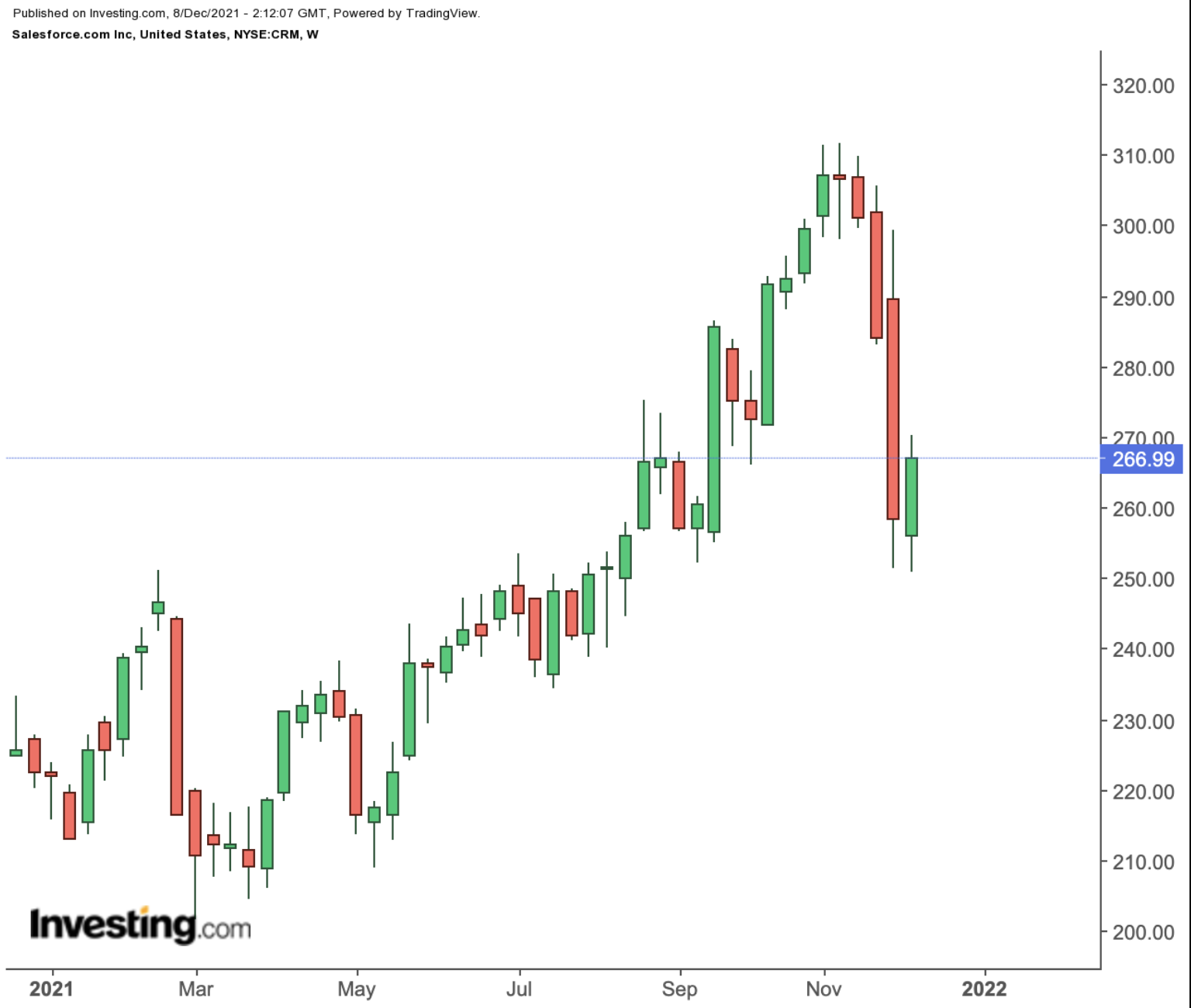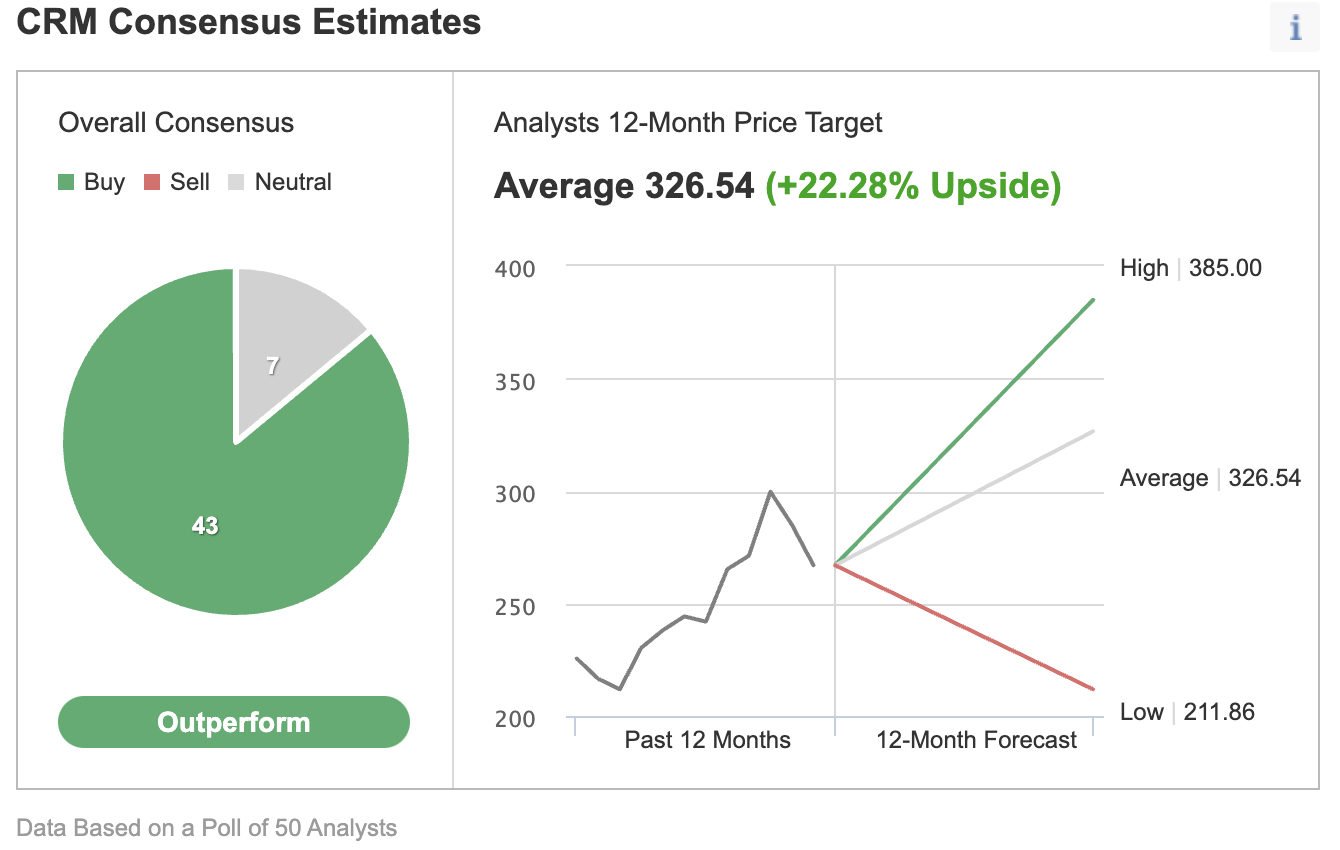Functional Brands closes $8 million private placement and completes Nasdaq listing
Investors in the Dow-30 member Salesforce.com (NYSE:CRM) have had a good year in 2021. The customer relationship management (CRM) giant, which trades around $267.04, is up more than 20.9% year-to-date. By comparison, the Dow Jones US Software Index has returned 34.6%. And the Dow Jones Industrial Average is up 16.8%.

Shares of Salesforce saw a record high of $311.75 on Nov. 9. However, since then bears have gotten the upper hand, and CRM lost about 15% of its value. The 52-week range for the stock has been between $201.51 - $311.75, while the company’s market capitalization stands at $206.5 billion.
Salesforce is regarded as one of most important names in Software-as-a-Service (SaaS) applications, also known as “Web-based software, on-demand software, or hosted software.”
Wall Street loves the SaaS business model since it means a steady and recurring revenue stream for a company like Salesforce. Around 150,000 firms use the Salesforce CRM product.
Recent metrics highlight:
“The global Software as a Service (SaaS) market size is projected to reach US$307.3 billion by 2026, from US$158.2 billion in 2020, at a CAGR of 11.7% during 2020-2026.”
On Nov. 30, Salesforce issued Q3 fiscal 2022 metrics. Revenue was $6.86 billion, up 27% year-over-year. Adjusted earnings per share (EPS) came in at $1.27 per share. Cash and marketable securities ended the quarter at $9.39 billion.
On the results, CEO Marc Benioff said:
“We delivered another phenomenal quarter, fuelling strong revenue growth, margin and cash flow… With the tremendous strength of our Customer 360 platform and Slack, we’re on track to reach $50 billion revenue in FY26.”
Despite the strength of Q3 numbers, management’s earnings guidance for Q4 fell short of expectations. And investors were not pleased.
Prior to the release of quarterly metrics, CRM stock was trading just shy of $300. Now, it is at $267.04.
Next Move In CRM Stock?
Among 50 analysts polled via Investing.com, Salesforce shares have an “outperform” rating, with an average 12-month price target of $326.54. Such a move would imply an increase of about 22% from the current level. The target range is between $211.86 and $385.

Chart: Investing.com
However, many investors are likely to be nervous about how CRM shares could fare in the coming weeks given the recent volatility in tech names as well as potential risks associated with the Omicron variant.
We expect Salesforce stock to potentially drop toward $250 or even slightly below. In that case, the $240 level should act as support.
Following such a potential decline, CRM shares are likely to trade sideways for several weeks, until they establish a base, possibly around $250, and then start a new leg up.
Therefore, Salesforce bulls with a two- to three-year horizon who are not concerned about short-term volatility could consider buying the stock around these levels for long-term portfolios. Others, who are experienced with options strategies and believe there could be further declines in CRM shares, might prefer to try a bear put spread.
However, most option strategies are not suitable for most retail investors. Therefore, the following discussion is offered for educational purposes and not as an actual strategy to be followed by the average retail investor.
Bear Put Spread On CRM Stock
Current Price: $267.04
In a bear put spread, a trader has a long put with a higher strike price as well as a short put with a lower strike price. Both legs of the trade have the same underlying stock (i.e., Salesforce here) and the same expiration date.
The trader wants CRM stock to decline in price. However, in a bear put spread, both the potential profit and potential loss levels are limited. Such a bear put spread is established for a net cost (or net debit), which represents the maximum loss.
Let’s look at this example:
For the first leg of this strategy, the trader might buy an at-the-money (ATM) or slightly out-of-the-money (OTM) put option, like the CRM Jan. 21, 2022, 260-strike put option. This option is currently offered at $9.70. It would cost the trader $970 to own this call option that expires in slightly less than two months.
For the second leg of this strategy, the trader sells an OTM put, like the CRM Jan. 21, 2022, 250-strike call option. This option’s current premium is $5.25. The option seller would receive $525, excluding trading commissions.
Maximum Risk
In our example, the maximum risk will be equal to the cost of the spread plus commissions. Here the net cost of the spread is $4.45 ($9.70 – $5.25 = $4.45).
As each option contract represents 100 shares of the underlying stock, i.e. CRM, we’d need to multiply $4.45 by 100, which gives us $445 as the maximum risk.
The trader could easily lose this amount if the position is held to expiry and both legs expire worthless, i.e., if the CRM price at expiration is above the strike price of the long put (or $260.00 in our example).
Maximum Profit Potential
In a bear put spread, potential profit is limited to the difference between the two strike prices minus the net cost of the spread plus commissions.
So in our example, the difference between the strike prices is $10.00 ($260.00 – $250.00 = $10.00). And as we’ve seen above, the net cost of the spread is $4.45.
The maximum profit, therefore, is $5.55 ($10.00 – $4.45 = $5.55) per share less commissions. When we multiply $5.55 by 100 shares, the maximum profit for this option strategy comes to $555.
The trader will realize this maximum profit if CRM price is at or below the strike price of the short put (lower strike) at expiration (or $250.00 in our example).
Those readers who have traded options before are likely to know that short put positions are typically assigned at expiration if the stock price is below the strike price (i.e., $250.00 here). However, there is also the possibility of early assignment. Therefore, the position would need monitoring up until expiration.
Break-Even CRM Price At Expiration
Finally, we should also calculate the break-even point for this trade. At that price, the trade will not gain or lose any money.
At expiration, the strike price of the long put (i.e., $260.00 in our example) minus the net premium paid (i.e., $4.45 here) would give us the break-even CRM price.
In our example: $260.00 − $4.45 = $255.55 (minus commissions).
Bottom Line On Salesforce Shares
We regard Salesforce stock to be a solid long-term choice for most retail portfolios. Despite the short-term choppiness in shares, its growth trajectory remains intact as its CRM platform provides significant competitive advantage.
Yet, the stock could come under further pressure in the weeks ahead. Therefore, a trading strategy as outlined here might be appropriate for traders with a bearish outlook on Salesforce shares.
